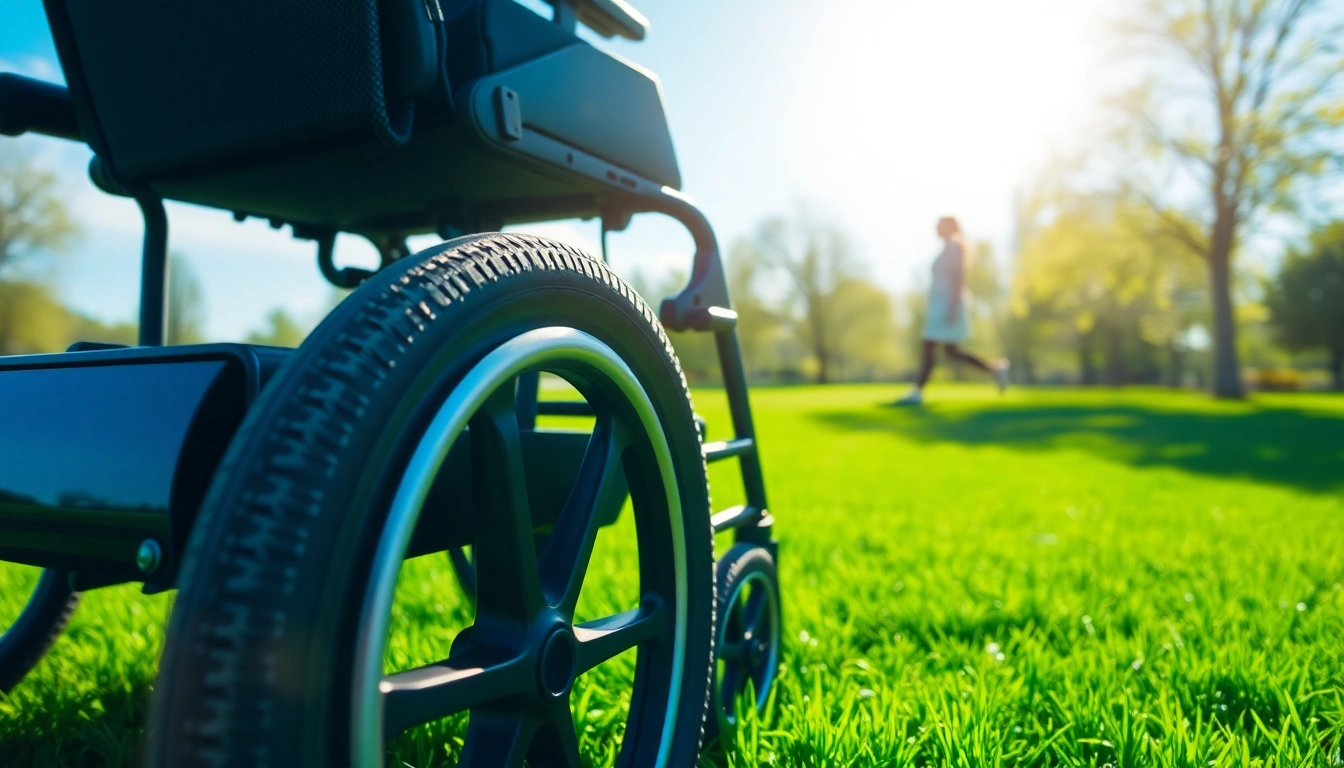Understanding Power Wheelchairs
What is a Power Wheelchair?
A power wheelchair, also known as an electric wheelchair, is a mobility device designed to assist individuals with limited mobility. Unlike manual wheelchairs, which require the user to navigate using their upper body strength, power wheelchairs are equipped with electric motors that provide propulsion and steering. Users can control their movement using a joystick or, in some cases, other adaptive controls tailored to their specific needs.
These wheelchairs come in various designs, ranging from compact models tailored for indoor use to robust versions built for outdoor terrains. As mobility solutions evolve, advanced features such as powered tilting, reclining, and adjusting seating positions are becoming standard, providing users not just increased independence, but also improved comfort.
Benefits of Using a Power Wheelchair
Power wheelchairs offer numerous benefits for users, enhancing mobility and overall quality of life. Here are some key advantages:
- Enhanced Mobility: Power wheelchairs allow users to navigate various terrains without needing assistance, promoting independence.
- Comfort and Support: Many power wheelchairs provide customizable seating options, allowing for prolonged use without discomfort, which is particularly beneficial for those with medical conditions that affect posture.
- Energy Efficiency: Using a power wheelchair reduces the physical strain on users as they no longer need to rely on upper body strength, making it easier to maintain social interactions and daily activities.
- Advanced Technology: Many models come equipped with technology that enhances user experience, including programmable controls, Bluetooth connectivity, and smart ergonomics.
Different Types of Power Wheelchairs
Power wheelchairs can be categorized into a few main types, each serving different user needs:
- Front-Wheel Drive: These wheelchairs offer excellent traction and stability, making them suitable for outdoor environments. The front wheels handle most of the weight, allowing for smoother control on rough terrains.
- Mid-Wheel Drive: These power wheelchairs provide superior maneuverability, making them ideal for indoor use. Users can turn in tight spaces without having to reposition.
- Rear-Wheel Drive: Known for their speed and longer range, rear-wheel drive power wheelchairs are perfect for those prioritizing outdoor travel and speed.
- All-Terrain Models: These are specially designed for rugged environments, featuring robust build quality to handle gravel, grass, and other challenging terrains.
Key Features to Consider
Motor and Battery Specifications
When selecting a power wheelchair, the motor and battery specifications are critical components to consider. A powerful motor ensures that users can navigate various terrains with ease. Look for models with at least a 200-watt motor for standard indoor use and up to 400 watts for outdoor use.
The battery life is equally crucial. Most power wheelchairs are equipped with rechargeable batteries, and users should consider the range – typically between 10 to 20 miles per charge. Lithium-ion batteries tend to be lighter and offer longer runtimes than standard lead-acid batteries.
Comfort and Ergonomics
Comfort is paramount when choosing a power wheelchair. Ergonomically designed seating with adjustable features, such as seat depth and angle, allows users to customize their chairs for maximum comfort. Look for wheelchairs with optional footrests, armrests, and headrests to ensure a supportive experience. Some models even come with memory foam cushions that adapt to the user’s body shape.
Safety Features and Accessories
Safety should never be compromised. Essential safety features such as anti-tip wheels, secure and easy-to-use brake systems, and reflectors for visibility can provide peace of mind. Additionally, consider accessories like seat belts and parking brakes, which can enhance user security.
Advanced models may also include features like hill-holding technology, which prevents the wheelchair from rolling backwards on inclines, and automatic pressure release systems that assist in preventing pressure sores during prolonged usage.
How to Choose the Right Power Wheelchair
Assessing Your Mobility Needs
Before purchasing a power wheelchair, it is essential to assess your mobility needs comprehensively. Consider factors such as:
- The primary environments where you will use the wheelchair (indoor vs. outdoor).
- Your level of physical strength and coordination, which can affect the control system you should choose.
- The frequency of use, which may determine the type of battery and motor necessary for your lifestyle.
- Any medical conditions or requirements that designate specific needs for seating or positioning.
Budget Considerations for Power Wheelchairs
Power wheelchairs can range significantly in price, often influenced by the model’s features, technology, and capabilities. Depending on your choices, prices can vary from $1,500 to $30,000. It is vital to establish a budget, considering not only the initial purchase price but also long-term maintenance costs and potential modifications.
Moreover, look into potential financial assistance options, including government programs, private insurance, or charitable organizations that may help subsidize some of the costs associated with acquiring a power wheelchair.
Customization Options Available
Customization can significantly enhance the usability and comfort of a power wheelchair. Look for options like custom seating, adjustable control systems (joysticks, sip-and-puff, or touch controls), and colors that express personal style. Choosing the proper accessories, such as oxygen tanks or cane holders, can also improve functionality.
Some manufacturers offer bespoke solutions based on individual needs, ensuring that your power wheelchair not only meets your mobility requirements but also aligns with your lifestyle.
Maintaining Your Power Wheelchair
Regular Maintenance Tips
Regular maintenance is essential to keep your power wheelchair functioning optimally. Here are some key maintenance tasks:
- Battery Care: Regularly check battery charge levels and clean battery terminals to avoid corrosion.
- Tire Checks: Inspect the tires for wear and adequate inflation to ensure smooth ride quality.
- Cleaning: Regularly clean the frame and components to prevent dirt build-up, particularly on the motors.
- Wiring and Electronics: Visual checks of wiring and electronic components can help identify issues early.
Troubleshooting Common Issues
Even with proper maintenance, users might encounter common issues, such as:
- Battery won’t charge: This could indicate a faulty charger or battery issue. Try using a different charger first before replacing the battery.
- Motor runs but wheels do not turn: This may suggest a problem with the drive mechanism, which may require professional assistance.
- Unusual noises when operating: Sounds that differ from normal operation often indicate a need for inspection of the motor or drivetrain.
When to Call a Professional for Repairs
While many users can perform routine checks, there are times when professional repairs are necessary. If you encounter severe issues such as electrical failures, structural problems, or if the wheelchair does not respond at all, it is crucial to contact a professional technician. Regular inspections by qualified technicians can also help resolve minor issues before they become significant problems.
Real-Life Experiences and Case Studies
User Testimonials on Power Wheelchairs
User experiences can provide invaluable insights into the practical benefits of power wheelchairs:
“Switching to a power wheelchair changed my life. I can now navigate my home without needing someone to help me and can even make spontaneous trips to the park.” – Sarah, 34.
“The ease of use in my power wheelchair has not only boosted my independence, but I feel like I’ve gained a new lease on life.” – John, 45.
Case Study: Adapting to a Power Wheelchair
Consider the case of Emily, a 52-year-old woman diagnosed with multiple sclerosis. Initially, Emily struggled with mobility issues and relied on a caregiver for assistance. After evaluating her needs, she decided to invest in a mid-wheel drive power wheelchair, allowing her greater independence.
Emily’s new wheelchair featured a reclining backrest and customizable seating — essential components for her prolonged sitting needs. Over time, she adapted seamlessly to her new wheelchair, empowering her to attend social events and participate more in her community.
Community Resources and Support Groups
Support groups offer valuable resources for individuals using power wheelchairs. Groups like the Power wheelchair user forums and local disability organizations can provide insights, share experiences, and offer assistance in navigating challenges associated with mobility issues. Such networks can also provide updates on technology advancements, which can further enhance users’ experiences.



